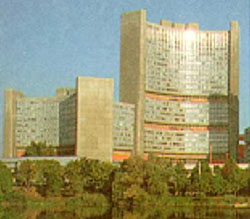| |
| Outline of Presentation |
 Background of IAEA Background of IAEA
 Technical Cooperation Technical Cooperation
 Programme Programme
 Strategy Strategy
 The East Asia and the Pacific Programme The East Asia and the Pacific Programme
 Model Project Criteria Model Project Criteria |
| IAEA : STATUTE |
The underlying basis for the IAEA's work is to facilitate the peaceful development of nuclear energy. Its Statute entered into force in 1957 and sets the framework for technical co-operation activities:
“The Agency shall seek to accelerate and enlarge the contribution of atomic energy to peace, health and prosperity throughout the world. It shall ensure, so far as it is able, that assistance provided by it or at its request or under its supervision or control is not used in such a way as to further any military purpose.” |
| IAEA : Background |
 135 Member States 135 Member States
 35 Member Governing Board 35 Member Governing Board
 46 years of international service 46 years of international service
 2,234 Professional and support staff 2,234 Professional and support staff
|
| IAEA : Financial Resources |
 $ 210,5 million regular budget for 2002 in addition extra-budgetary contributions received amounting to $42,4 million for 2002 $ 210,5 million regular budget for 2002 in addition extra-budgetary contributions received amounting to $42,4 million for 2002
 $ 57,5 million for 2002 in voluntary contributions paid to the Agency’s Technical Co-operation Fund $ 57,5 million for 2002 in voluntary contributions paid to the Agency’s Technical Co-operation Fund |
| Technical Co-operation Fund (TCF) |
 Voluntary contribution by member States: Voluntary contribution by member States:
 Targets established by Member States Targets established by Member States
 Pledge Pledge
 Payments Payments
 Rate of Attainment Rate of Attainment
 Assessed programme costs =8% of TC delivered Assessed programme costs =8% of TC delivered
 Miscellaneous income Miscellaneous income
 Extra-budgetary fund : Extra-budgetary fund :
 From Members States From Members States
 UNDP UNDP
 Cost sharing Cost sharing
|
| THE DEPARTMENT OF TECHNICAL COOPERATION (TC) |
 Mission: Management of Technical Cooperation for Development Mission: Management of Technical Cooperation for Development
 Objective: To contribute to tangible social and economic benefits and scientific advancement in member states Objective: To contribute to tangible social and economic benefits and scientific advancement in member states
 Administrative Budget: (2002-03) $29.4 million Administrative Budget: (2002-03) $29.4 million |
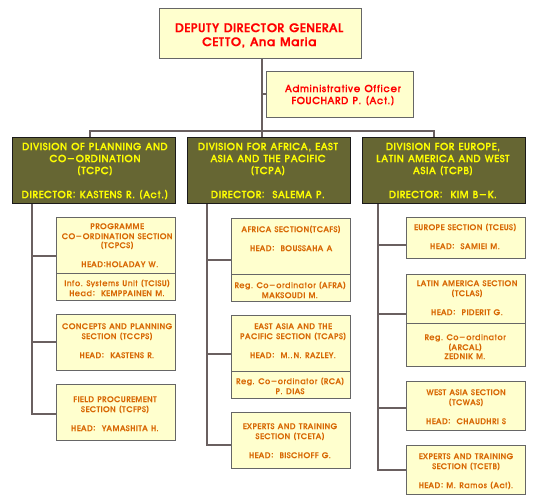 |
| TC Programme - Quick Facts |
 New obligations: US $74,6 million in 2002 New obligations: US $74,6 million in 2002
 Programmes: National, Regional, Inter-regional Programmes: National, Regional, Inter-regional
 Agency has national TC programmes in approximately 100 countries Agency has national TC programmes in approximately 100 countries
 2/3rds of these are non-nuclear power countries 2/3rds of these are non-nuclear power countries
 25 recipient countries participating in the TCP are LDCs 25 recipient countries participating in the TCP are LDCs
 Regional programmes: Regional Agreements (4) and non-Agreement regional Regional programmes: Regional Agreements (4) and non-Agreement regional
 TC Department has approx. 200 staff TC Department has approx. 200 staff |
| Major Field of Areas of the TC Programme in 2002 |
 Safety (nuclear installations, Safety (nuclear installations,
 radiation safety, nuclear waste) 24% radiation safety, nuclear waste) 24%
 Human Health 19% Human Health 19%
 Food & Agriculture 14% Food & Agriculture 14%
 Industrial Applications 9% Industrial Applications 9%
 Nuclear Science 7% Nuclear Science 7%
 Water Resources Management 6% Water Resources Management 6%
 Nuclear Power 4% Nuclear Power 4% |
| The IAEA’s TC programme: Trends |
 The use of nuclear technologies in developing countries is growing as local infrastructures improve and technology transfer increases. The use of nuclear technologies in developing countries is growing as local infrastructures improve and technology transfer increases.
 Interest is increasing among both donors and recipients in technologies that help respond to and accelerate the achievement of development goals (e.g. relieving hunger, improving health care, providing access to safe drinking water). Interest is increasing among both donors and recipients in technologies that help respond to and accelerate the achievement of development goals (e.g. relieving hunger, improving health care, providing access to safe drinking water).
 Some countries and institutions are becoming more self reliant as viable markets develop for nuclear technologies, based on an increased awareness of their benefits. Some countries and institutions are becoming more self reliant as viable markets develop for nuclear technologies, based on an increased awareness of their benefits. |
| THE IAEA’S TC PROGRAMME: CHALLENGES |
| To convince donor and recipient governments that nuclear applications and consequently, TC projects are an effective and safe means of addressing important economic and social problems. |
| TC: MANDATE FROM THE BOARD |
 To ensure that TC assistance is based on the most cost-effective nuclear technologies/techniques To ensure that TC assistance is based on the most cost-effective nuclear technologies/techniques
 To ensure sustainability and impact of the assistance provided To ensure sustainability and impact of the assistance provided
 In short, to apply the MODEL PROJECT discipline to the entire TC programme In short, to apply the MODEL PROJECT discipline to the entire TC programme |
| TC STRATEGY |
 Following the Board’s mandate, TC has developed the strategy with the main objective of ensuring that its limited resources are spent only where the IAEA work can be most beneficial and cost- effective, with measurable and sustainable impact, for solving high priority development problems Following the Board’s mandate, TC has developed the strategy with the main objective of ensuring that its limited resources are spent only where the IAEA work can be most beneficial and cost- effective, with measurable and sustainable impact, for solving high priority development problems
 The strategy also aims at improving the design and delivery of the TC programme and assumes a more pro-active role for TC programmers as opposed to the past The strategy also aims at improving the design and delivery of the TC programme and assumes a more pro-active role for TC programmers as opposed to the past |
| TC STRATEGY: OBJECTIVES |
| The main aims of the 1997 Technical Co-operation Strategy were to ensure: a demand driven approach to technical co-operation; the relevance of TC projects to development priorities; and improved project quality.
The 2002 review confirmed the original Strategic Goal:
to increasingly promote tangible socio-economic impact by contributing directly in a cost-effective manner to the achievement of the major sustainable development priorities of each country.
|
| TC STRATEGY: CURRENT STATUS |
 endorsed by the Board in December 1997 endorsed by the Board in December 1997
 milestones came due at the end of 2000 milestones came due at the end of 2000
 report card presented to TACC Dec. 2000 report card presented to TACC Dec. 2000
 2002 review of the achievements 2002 review of the achievements
 new milestones established to end 2005 (GOV/INF/2002/8/Mod.1) new milestones established to end 2005 (GOV/INF/2002/8/Mod.1) |
| TC STRATEGY: DIRECTIONS |
 Strengthen self-reliance and sustainability of counterpart organizations Strengthen self-reliance and sustainability of counterpart organizations
 Build partnerships with development organizations Build partnerships with development organizations
 Focus technology on the roots of Poverty Focus technology on the roots of Poverty
 Result-based ? tangible benefits for targeted population groups Result-based ? tangible benefits for targeted population groups
 Compete in the technology marketplace. Compete in the technology marketplace. |
| TC STRATEGY: ELEMENTS |
 Model Project Model Project
 CPF CPF
 Thematic Plans Thematic Plans
 Partnerships Partnerships |
 Co-funding Co-funding
 Sustainability Sustainability
 TCDC TCDC |
|
| THE MODEL PROJECT CONCEPT THE MEANS OF ACHIEVING THE TC GOAL |
 Model Project Concept was the most important of the three mechanisms IAEA uses to implement the strategic goal for technical cooperation. Model Project Concept was the most important of the three mechanisms IAEA uses to implement the strategic goal for technical cooperation.
 It provides the framework for moving from institution based projects to beneficiary based projects that serve targeted end-users. It provides the framework for moving from institution based projects to beneficiary based projects that serve targeted end-users.
 The end-user - in IAEA terminology - is the last link in the chain that connects technology with the problem holder. Reaching the end-user is the underlying objective for all Model Projects and the key concept underlying the TC Strategy. The end-user - in IAEA terminology - is the last link in the chain that connects technology with the problem holder. Reaching the end-user is the underlying objective for all Model Projects and the key concept underlying the TC Strategy. |
| THE MODEL PROJECT CRITERIA |
 respond to a real need; respond to a real need;
 reflect an indispensable role for the nuclear technology involved; reflect an indispensable role for the nuclear technology involved;
 produce significant economic or social impact; and produce significant economic or social impact; and
 have demonstrated potential for sustainability through strong Government commitment. have demonstrated potential for sustainability through strong Government commitment.
The Model Project approach is now implemented in all TC Activities, while sustainability through Government commitment has become the guiding “Central Criterion” |
| THE CENTRAL CRITERION |
|
A project meets the central criterion if it addresses an area of defined need in which there is a national programme enjoying strong government commitment and support.
Such project take two forms:
 those that produce a tangible socio-economic benefit in an area in which nuclear technology holds a comparative advantage; those that produce a tangible socio-economic benefit in an area in which nuclear technology holds a comparative advantage;
 those that clearly support an enabling environment for the use of nuclear technologies(such as safety infrastructure or energy planning). those that clearly support an enabling environment for the use of nuclear technologies(such as safety infrastructure or energy planning).
|
| COUNTRY PROGRAMME FRAMEWORK (CPF) |
| Improves the project selection process by placing it in the context of national priorities. CPFs help national authorities to identify the problems to be addressed with nuclear technologies and visualize the results expected in a given time frame. CPFs are the principal means of implementing the central criterion. A key to the success of CPFs is for governments to take ownership of the process. |
| Country Programme Frameworks (CPF) |
Aim: to achieve agreement between the Agency and the Government to focus on a limited number of priority
areas for the TC Programme in the coming years.
Experience has shown that the CPF process is at least as important as the product |
| THEMATIC PLANNING |
| Thematic planning is a process by which specific problems are identified for which the transfer of nuclear technology through technical co-operation can be expected to result in significant impact, because of the distinct advantages of the nuclear technology involved.. Selected technical themes should be given greater emphasis, as appropriate, by publicizing success stories, informing Member State governments on actual or potential benefits, conducting studies, and seeking to identify potential partners. |
| Thematic Planning |
 Identification of best practices, key stakeholders/partners in a thematic area; Identification of best practices, key stakeholders/partners in a thematic area;
 Comparative assessment of nuclear techniques with conventional techniques - clarifying the Agency’s role; Comparative assessment of nuclear techniques with conventional techniques - clarifying the Agency’s role;
 Identification of key countries for programmes using a given technology; Identification of key countries for programmes using a given technology;
 Mapping the way forward: CRPs, TCP Mapping the way forward: CRPs, TCP |
| PARTNERSHIPS |
a)Financial: partnerships between the Agency and large donor organizations;
b)Strategic: partnerships raise the profile of nuclear science in development. Raising the profile of the Agency’s TC programme is not an end in itself; rather, in the effort to attract partners, it promotes awareness of the nuclear technologies available and, significantly, of tangible benefits from their application;
c)Technical: technical partnerships achieve synergy by combining complementary nuclear and non-nuclear technologies. |
| PRINCIPLES OF FUNDING |
 IAEA is not a funding organization. IAEA is not a funding organization.
 Project fund raising is at least a joint activity between the Agency and Member States, and at best a concerted government objective. Project fund raising is at least a joint activity between the Agency and Member States, and at best a concerted government objective.
 The Technical Co-operation Fund is too small to realize social-economic impact in most Member States. TCF must be used to demonstrate the tangible benefits of applications that attract major funding (seed money). The Technical Co-operation Fund is too small to realize social-economic impact in most Member States. TCF must be used to demonstrate the tangible benefits of applications that attract major funding (seed money).
 Funding is competitive: the best projects attract the most money. Funding is competitive: the best projects attract the most money. |
| FUNDING |
| In part, new funding for technical co-operation should come through partnerships with non-traditional donors. New funding also comes from recipient Member States that are prepared to share project costs, because of the tangible benefits that accrue to them through Agency assistance. |
| CO-FUNDING |
 Other agencies are not automatically aware of IAEA projects Other agencies are not automatically aware of IAEA projects
 TC is actively working to acquaint other agencies both in general and in terms of specific projects TC is actively working to acquaint other agencies both in general and in terms of specific projects
 Much of this process of informing and educating can best be done at the country level Much of this process of informing and educating can best be done at the country level |
CO-FUNDING
Using support from two or more sources |
 The IAEA has projects that work and produce useful results if carried through to the end user The IAEA has projects that work and produce useful results if carried through to the end user
 Applications through the right end user can involve experiences beyond the means of the IAEA Applications through the right end user can involve experiences beyond the means of the IAEA
- E.g. taking the results of mutation breeding programme through field tests and national agricultural extension programme to farmers |
| SUSTAINABILITY OF BENEFITS |
 National ownership of TC programmes; National ownership of TC programmes;
 Careful selection, and; Careful selection, and;
 Leveraging of Agency resources. Leveraging of Agency resources.
All help to ensure the long term viability of country programmes.
However, the ultimate factor in sustainability is the degree to which countries and individual institutions can achieve technical and financial self-reliance. |
| ASSISTING COUNTRIES AND INSTITUTIONS TOWARDS SELF RELIANCE |
 At the institutional level, this role includes encouraging management to develop “markets” or “customers” for their products and services; At the institutional level, this role includes encouraging management to develop “markets” or “customers” for their products and services;
 At the national level, it means encouraging Member States to enhance strategic planning for the nuclear sector, to solidify their support for areas in which nuclear technologies can best serve national priorities. At the national level, it means encouraging Member States to enhance strategic planning for the nuclear sector, to solidify their support for areas in which nuclear technologies can best serve national priorities.
 At the regional level, it involves encouraging Member States to work collectively towards rationalizing services and products so that individual institutions can remain viable. At the regional level, it involves encouraging Member States to work collectively towards rationalizing services and products so that individual institutions can remain viable. |
| Self-Reliance |
 Agency assists countries and institutions that are ready to move towards self-reliance. Agency assists countries and institutions that are ready to move towards self-reliance.
 TCP strengthens capacity of institutions in Member States using nuclear technologies to become more technically and financially self-reliant. TCP strengthens capacity of institutions in Member States using nuclear technologies to become more technically and financially self-reliant.
 This will ensure sustainability. This will ensure sustainability. |
| OWNERSHIP AND SUSTAINABILITY |
 Regional Cooperation Mechanisms. Regional Cooperation Mechanisms.
 Field management structure where leadership, planning, organization and control of projects coming from member states. Field management structure where leadership, planning, organization and control of projects coming from member states.
 Strong regional base for expert services and host institutions. Strong regional base for expert services and host institutions.
 Formal agreements with regional institutions to “outsource” implementation activities. Formal agreements with regional institutions to “outsource” implementation activities.
 Strong technical inter-dependence among scientific institutions and common ownership of technology packages such as Tissue Banking. Strong technical inter-dependence among scientific institutions and common ownership of technology packages such as Tissue Banking. |
| Regional Cooperation Mechanisms |
 Regional Cooperation Agreement (RCA) for East Asia and the Pacific Regional Cooperation Agreement (RCA) for East Asia and the Pacific
 African Regional Co-operative Agreement for Research, Development and Training Related to Nuclear Science and Technology among African Member States (AFRA). African Regional Co-operative Agreement for Research, Development and Training Related to Nuclear Science and Technology among African Member States (AFRA).
 Regional Cooperation Agreement for the Promotion of Nuclear Science and Technology in Latin Americana the Caribbean. (ARCAL). Regional Cooperation Agreement for the Promotion of Nuclear Science and Technology in Latin Americana the Caribbean. (ARCAL).
 Regional intergovernmental agreements provide opportunities for cooperation among IAEA counterpart organization. The IAEA acts as Technical Secretariat. Regional intergovernmental agreements provide opportunities for cooperation among IAEA counterpart organization. The IAEA acts as Technical Secretariat. |
| TECHNICAL COOPERATION AMONG DEVELOPING COUNTRIES (TCDC) |
 Many developing Member States have strong technical capabilities in nuclear technology and its applications. Many developing Member States have strong technical capabilities in nuclear technology and its applications.
 The experience of succeeding in difficult circumstances may be of more value than that of a developed country The experience of succeeding in difficult circumstances may be of more value than that of a developed country
 TCDC will often be less expensive TCDC will often be less expensive |
| TCDC |
 Contributing sustainable delivery of services to target beneficiaries by end-users after completion of Agency TC Projects. Contributing sustainable delivery of services to target beneficiaries by end-users after completion of Agency TC Projects.
 Sharing of resources and skills Sharing of resources and skills
 Use of Regional Centers (RRU, RRC) Use of Regional Centers (RRU, RRC) |
TECHNICAL COOPERATION PROGRAMME
The East Asia and the Pacific Region
|
| Financial Resources (Hardcore) |
| Programmes |
Regional |
RCA |
|
Regional Total |
National Total |
Ease Asia Total |
|
% Share of
Regional of Total |
| 1993 |
|
851,250 |
|
851,250 |
7,421,100 |
8,272,350 |
|
10 |
| 1994 |
|
1,222,600 |
|
1,222,600 |
8,926,950 |
10,149,550 |
|
12 |
| 1995 |
432,200 |
1,632,800 |
|
1,632,800 |
7,118,340 |
8,751,140 |
|
19 |
| 1996 |
321,700 |
1,653,600 |
|
1,653,600 |
7,183,608 |
8,837,208 |
|
19 |
| 1997 |
197,940 |
2,315,700 |
|
2,315,700 |
6,871,853 |
9,187,553 |
|
25 |
| 1998 |
1,211,975 |
3,740,342 |
|
3,740,342 |
8,139,209 |
11,879,551 |
|
31 |
| 1999 |
2,103,205 |
4,830,085 |
|
4,830,085 |
8,197,480 |
13,027,565 |
|
37 |
| 2000 |
2,153,710 |
5,152,585 |
|
5,152,585 |
6,153,720 |
11,306,305 |
|
46 |
| 2001 |
2,500,940 |
4,951,410 |
|
4,951,410 |
7,906,266 |
12,857,676 |
|
39 |
| 2002 |
2,560,650 |
4,912,310 |
|
4,912,310 |
7,191,235 |
12,103,545 |
|
41 |
| 2003 |
2,720,972 |
5,656,360 |
|
5,656,360 |
7,360,704 |
13,017,064 |
|
43 |
| 2004 |
2,521,432 |
5,705,784 |
|
5,705784 |
7,312,043 |
13,017,827 |
|
44 |
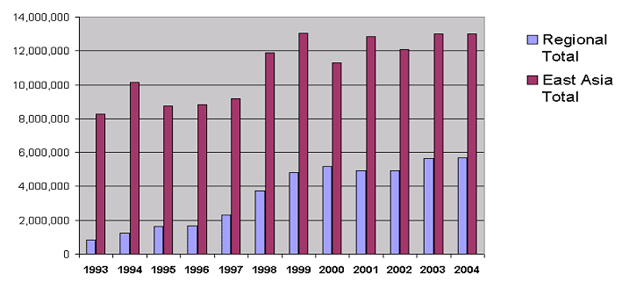 |
| 2003-2004 TC Programme |
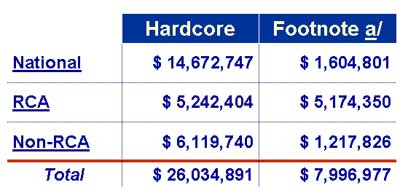 |
| 2003 TC Programme Hardcore |
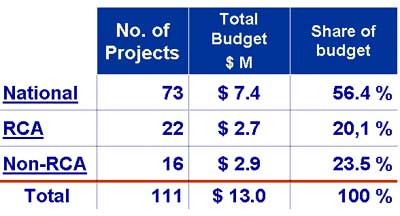 |
| Total Programme for 2003 (as of 31 January 2003) |
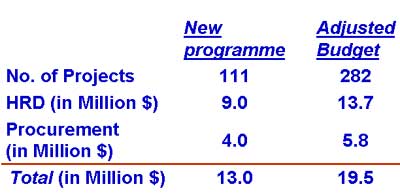 |
RCA Programme ? Financial Resources (Hardcore)
As of 31 January 2003 |
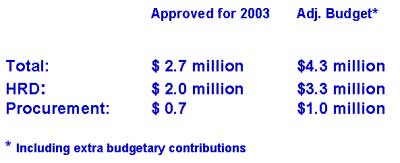 |
| MS Participation in National and Regional Projects |
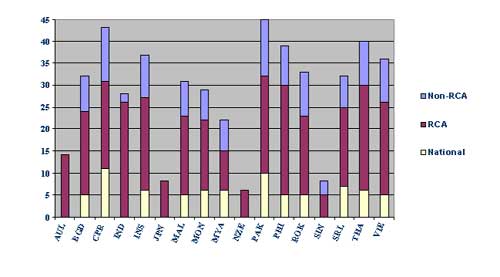 |
| Projects with future year budget commitment |
| CO: Projects with budget already indicated in the 2003-2004 TCP
CI: Projects designed in 2003-2004 TCP for 2005-2006 and beyond, but no budget figures for 2005-2006 are given
CII: Projects with no component beyond 2004 TCP but strongly expected to be extended or continue in
2005-2006
|
| The Region Future Year Commitments |
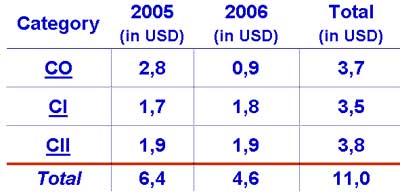 |
| Distribution of 2005-2006 TCF Commitments |
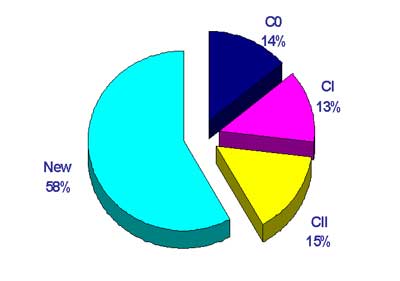 |
| RCA Programme with Future Year Commitments(Hardcore) |
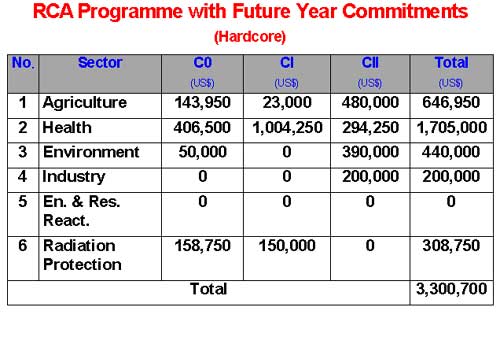 |
| Distribution 2003 by Budget and Field |
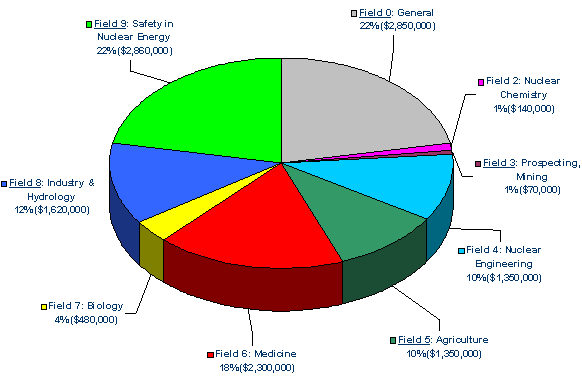 |
| Country Programme Framework (CPF) - Status |
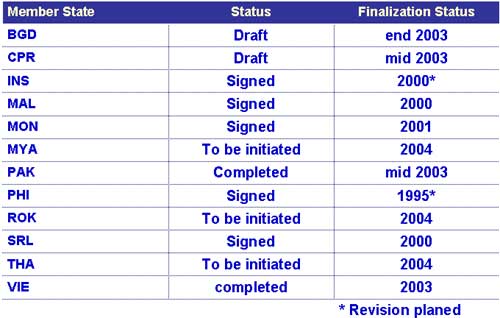 |
| Summary |
 Financial Resources are limited Financial Resources are limited
 Member States and Secretariat have to cooperate to implement activities included in project workplans Member States and Secretariat have to cooperate to implement activities included in project workplans
 > 45 % of 2005-2006 budget have been committed > 45 % of 2005-2006 budget have been committed
 Less than half of the East Asia and the Pacific Region TCP recipients have finalized and signed a CPF document Less than half of the East Asia and the Pacific Region TCP recipients have finalized and signed a CPF document |
| BASIC IN THE PREPARATION OF PROJECT PROPOSALS TO MEET TC STRATEGY OBJECTIVES |
 To consider Central Criterion to obtain sustainable benefits within the framework of national and regional development plans To consider Central Criterion to obtain sustainable benefits within the framework of national and regional development plans
 To consider strategic partnerships to gain recognition as a partner for the cost effective transfer of nuclear technologies that contribute to the resolution of development problems. To consider strategic partnerships to gain recognition as a partner for the cost effective transfer of nuclear technologies that contribute to the resolution of development problems.
 To consider diverse possibilities of funding to solve development problems To consider diverse possibilities of funding to solve development problems
 To search for sustainability by strengthening the capacity of institutions in Member States using nuclear technologies to become more technically and financially self-reliant To search for sustainability by strengthening the capacity of institutions in Member States using nuclear technologies to become more technically and financially self-reliant
|



